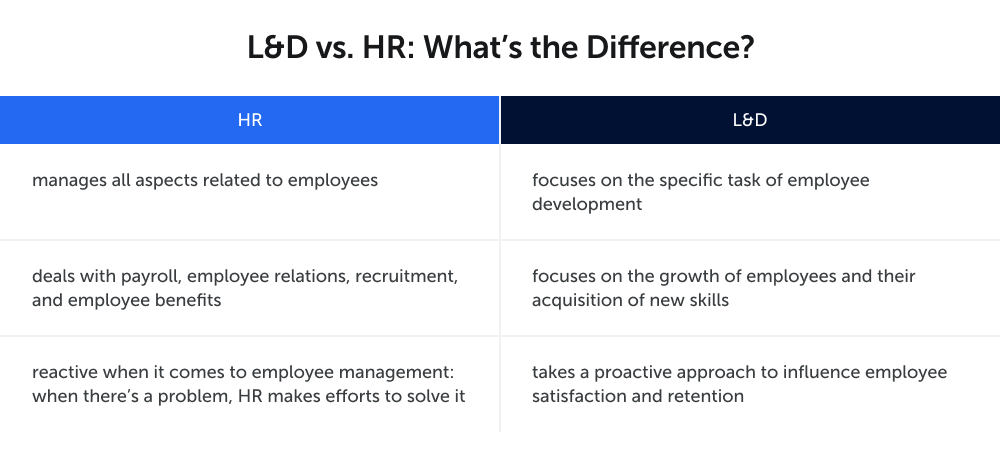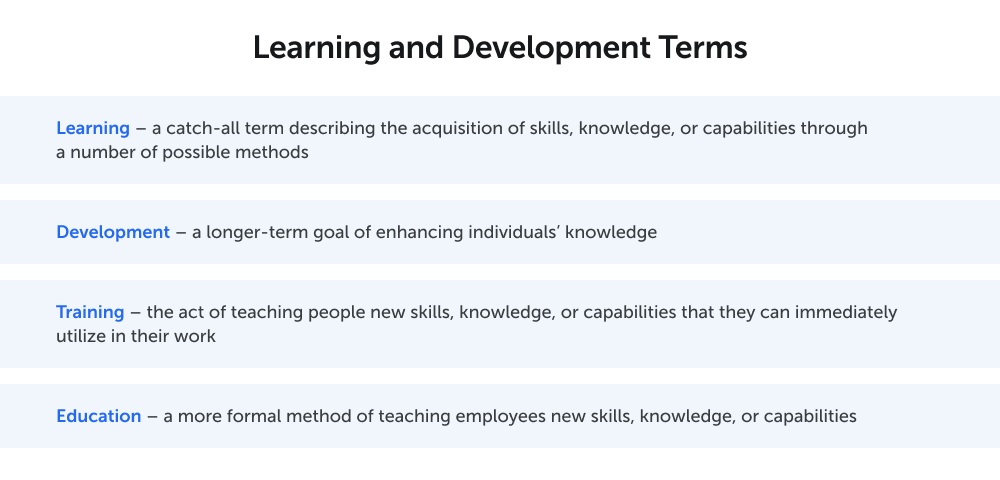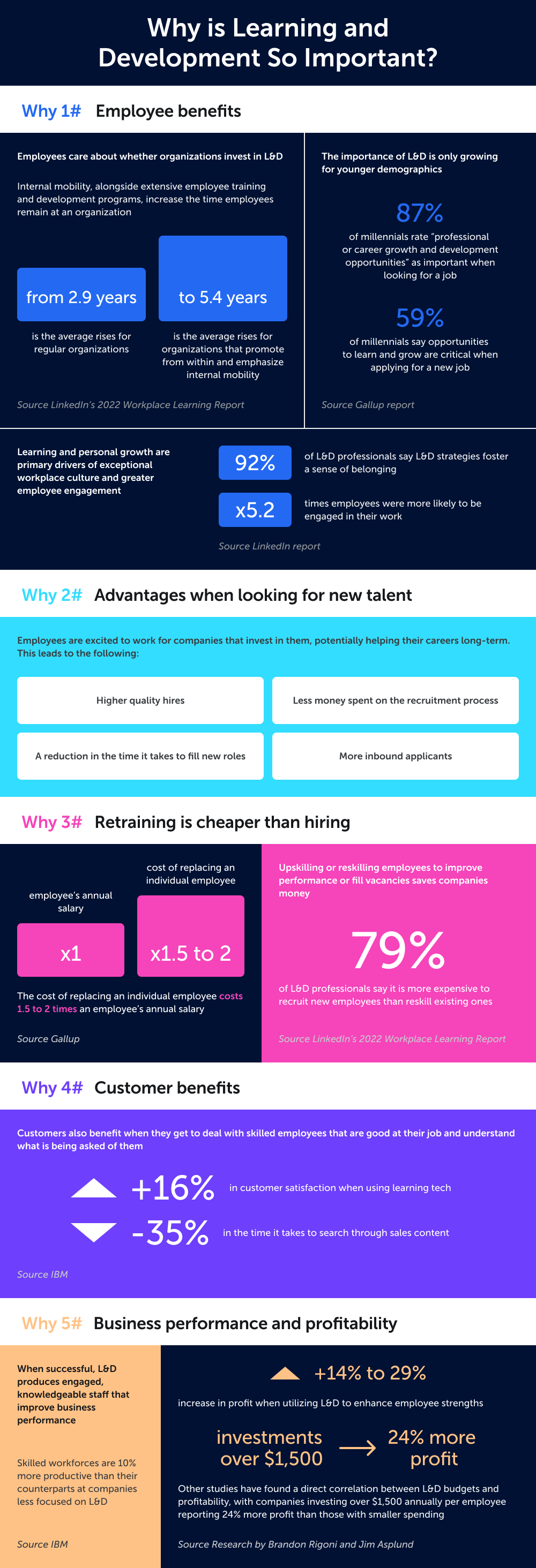Learning and development fundamentals
Learn what learning and development is and why it is so important. Discover main areas, terms, challenges, jobs, and the key difference between HR and L&D.

Learning and development is a critical component of every business, regardless of industry, size, or business model.
With effective L&D practices, organizations can build a workforce capable of delivering their business goals.
In this piece, we will cover the following:
- What is learning and development?
- L&D vs. HR: What’s the difference?
- Learning and development terms
- Why is learning and development so important?
- L&D challenges
- Who is responsible for L&D?
- Examples of L&D programs
- The future of L&D
What is learning and development?
Investing in employee learning and development is a reliable way for organizations to generate a greater return from their staffing expenditure, improving overall profitability.
A broad term, L&D covers all professional development within an organization and is considered a core function of human resource (HR) operations. This includes formal, instructor-led educational programs and informal, employee-driven learning. L&D is sometimes referred to as talent development, training and development, or learning and performance.
Beyond improving performance, staff learning and development initiatives can produce greater employee engagement and retention rates and foster an additive work culture or learning ecosystem.
L&D is also vital to an organization’s talent management strategy, offering new opportunities to help acquire and maximize employees.

L&D strategy framework
You will receive a list of questions along with a spreadsheet template to help you analyse your L&D strategy.
DOWNLOAD FRAMEWORKThe importance of employee training and development has only increased, given the introduction of new technologies into the workplace.
With the digitization of many business practices, organizations now require technically capable workforces.
L&D is a critical tool to bridge the growing skills gap and future-proof employees by ensuring they have the digital literacy to operate effectively in the modern economy.
Employee learning and development initiatives can take many forms, from classroom-style training courses or online learning to mentorships and personalized educational programs designed to maximize each individual’s skills.

L&D can aid every aspect of the employee lifecycle. For example:
- Introducing business processes and best practices during onboarding
- Compliance training to teach employees the regulations and policies of the organization
- On-the-job training to demonstrate the specific skills needed to perform a particular role
- The sharing of institutional knowledge from experienced to newer workers
- Upskilling or reskilling to improve performance or transition staff to new roles
- Enhancing communication skills for better collaboration
- Instilling leadership capabilities for smooth internal succession planning
L&D vs. HR: What’s the difference?

The critical difference between L&D and HR is that HR manages all aspects related to employees, and L&D focuses on the specific task of employee development.
While HR staff deal with payroll, employee relations, recruitment, and employee benefits, L&D professionals’ sole focus is the growth of employees and their acquisition of new skills.
There is a significant overlap between the two involved in onboarding, change management, succession planning, and employee assessment.
While sometimes L&D is independent or the responsibility of each department, generally speaking, it is overseen by the HR department.
Regardless of how a business organizes its HR and L&D operations, both must work in parallel to create a productive workforce capable of achieving the broader business goals.
Learning and development terms

While several related terms can be used interchangeably within the field, it is good to ensure you clearly define each concept and recognize the slight nuances between them. These include:
- Learning – A catch-all term describing the acquisition of skills, knowledge, or capabilities through some possible methods. These include experience, self-study, or teaching. Learning is the building block of development, training, and education.
- Development – A longer-term goal of enhancing individuals’ knowledge. This could be either their depth of knowledge on a particular subject or their breadth of knowledge, introducing them to new topics. The organization’s broader goals govern employee development programs.
- Training – The act of teaching people new skills, knowledge, or capabilities they can immediately utilize in their work. This could improve performance and workplace safety or adapt to a new role and workplace operations.
- Education – A more formal method of teaching employees new skills, knowledge, or capabilities. Education may be less specific than training, with a longer-term view of employee expertise.
Why is learning and development so important?

Learning and development is essential for staff, leadership, and customers. It helps employees develop their skills and expertise to advance their careers and open new opportunities.
Businesses can build the workforce they need, improve performance, and increase profitability.
Finally, customers have a better experience interacting with well-trained, knowledgeable staff who know how to help them and can make insightful suggestions.
1. Employee benefits
Employees care about whether organizations invest in L&D. It shows their leadership is committed to their personal growth and is willing to develop existing staff members rather than looking to progress through new hires.
In addition, L&D solid programs are linked to greater internal mobility, with organizations willing to take the time to teach employees skills that could help them in new, often more rewarding, roles.
LinkedIn’s 2022 Workplace Learning Report found internal mobility alongside extensive employee training and development programs increase the time employees remain at an organization. The average rises from 2.9 years for regular organizations to 5.4 years for organizations that promote from within and emphasize internal mobility.

Research also shows the importance of L&D is only growing for younger demographics.
For example, a Gallup report found that 87% of millennials (typically defined as the generation born from the early 1980s to the mid-1990s) rate “professional or career growth and development opportunities” as important when looking for a job.
In addition, 59% of millennials say opportunities to learn and grow are critical factors when applying for a new job.

Emphasis on L&D produces a range of benefits for employees themselves.
LinkedIn found learning and personal growth to be primary drivers of exceptional workplace culture and greater employee engagement. When people feel like they are learning and progressing in their professional life, they are more committed to their employers, willing to work harder and go further for a common cause.
A previous LinkedIn report found community-based L&D strategies were particularly advantageous, fostering a sense of belonging, according to 92% of L&D professionals surveyed. This comradery meant employees were 5.2 times more likely to be engaged in their work.

Employee engagement, enhanced through L&D programs, generates a range of benefits:
- Higher employee retention
- Reduced stress in the workplace with competent and confident staff capable of delivering
- The discovery of hidden potential within the workforce
- More outstanding work-life balance among staff members
- Increased job security
2. Advantages when looking for new talent
While these benefits are great for existing employees, they filter through the hiring process. Companies that demonstrate their commitment to L&D, making it part of their employer branding, do better when looking to recruit new talent.
Employees are excited to work for companies that invest in them, potentially helping their careers long-term. This leads to the following:
- Higher quality hires
- A reduction in the time it takes to fill new roles
- Less money spent on the recruitment process
- More inbound applicants
3. Retraining is cheaper than hiring
While L&D improves employer branding to help the hiring process, it also reduces the need for it.
Retraining staff to learn new roles within the company benefits employees, who get to advance their careers, and employers, who cut workforce costs.

Upskilling or reskilling employees to improve performance or fill vacancies saves companies money.
Conservative estimates from Gallup suggest it costs 1.5 to 2 times an employee’s annual salary to replace them.
And LinkedIn’s 2022 Workplace Learning Report found that 79% of L&D professionals say it is more expensive to recruit new employees than reskill existing ones.

4. Customer benefits
Customers also benefit when they get to deal with skilled employees that are good at their job and understand what is being asked of them.
When contacting a company, customers want to deal with enthusiastic, engaged employees who are experts in their field and clearly understand the product or service being discussed.
L&D can reduce the time it takes to answer any queries and improve the quality of responses, so customers are more likely to get a quick and accurate solution the first time. This boosts customer satisfaction and helps produce repeat customers willing to return after a successful experience.
Employees trained to deal with customers directly and help them on their sales journey produce a range of benefits.

For example, IBM found organizations taking advantage of learning solutions to generate skilled workforces have significant customer benefits, including a 16% increase in customer satisfaction when using learning tech and a 35% reduction in the time it takes to search through sales content.
5. Business performance and profitability
When successful, L&D produces engaged, knowledgeable staff that improves business performance.
This can be measured in various ways, including:
- Increasing productivity and the number of work employees can complete
- Higher customer satisfaction
- Attracting new customers and spotting emerging opportunities in the market
- Greater efficiency and better use of company resources to reduce outlays
These benefit business performance, affecting the bottom line and increasing profits. The same IBM study mentioned above found that skilled workforces are 10% more productive than their counterparts at companies less focused on L&D.

Research shows utilizing L&D to enhance employee strengths leads to an increase in profit ranging from 14% to 29%. Other studies have found a direct correlation between L&D budgets and profitability, with companies investing over $1,500 annually per employee reporting 24% more profit than those with smaller spending.

L&D strategy framework
You will receive a list of questions along with a spreadsheet template to help you analyse your L&D strategy.
DOWNLOAD FRAMEWORKL&D challenges
While L&D is critical for business success, the process itself is not without its challenges:

- Meeting the needs of a diverse workforce – L&D has to adapt and be effective regardless of the audience.For example, it requires delivering content applicable to multigenerational teams that span younger, more technically savvy, inexperienced employees through to older, more traditional workers with significant experience that might be stuck doing things in a certain way. It is down to L&D staff to tailor training courses to help both develop the skills they are lacking. Further readings: Diversity and Inclusion (DEI) Training in the Workplace
- Soft skills – Teaching specific hard skills related to a role is more manageable than helping staff develop the soft skills required to collaborate and enhance the modern workplace. Further readings: Hard Skills vs. Soft Skills
- Hybrid work models – The rise of hybrid work models and employees splitting time between the office and working from home has created new challenges for L&D staff. Training programs have had to come to terms with fragmented workforces, relying more on e-learning and finding ways to continue promoting collaborative learning.
- Generating engagement – One of the most challenging aspects of training is creating the engagement needed for employees to walk away from a session having learned something. Engagement relies on the content and how it is delivered, including the trainer’s or facilitator’s style and skills. Further readings: 5 Ways to Improve Employee Engagement with L&D
- Measuring effectiveness – Engaged learners typically mean an L&D program is effective, but how do we measure the overall effectiveness of training courses? Organizations need to develop meaningful learning metrics that track knowledge transfer and how it is applied in the workplace. Further readings: 10 Valuable Training Metrics to Know
- ROI – Companies aren’t in the business of losing money; this holds for L&D. Training programs have to pay for themselves and more, proving that the outcomes produced are more significant than the money spent.
Learning and development in large and small companies
L&D is a broad term, and the specifics of its implementation vary considerably depending on the size of the company.
Learning and development in large companies
Larger companies typically have the resources to implement highly structured L&D strategies overseen by a dedicated team within the HR department working full-time to improve employee capabilities.
This generally incorporates technology such as a learning management system (LMS) to store and deliver training material or a learning experience platform (LXP) to track individual employees and tailor specific development programs.
With more resources available, employee learning and development at larger companies can feel more formal and prescribed compared to smaller operations.
Moreover, with more employees to teach, big companies can invest in external training providers to deliver specialist information to a large number of people at the same time.
Lacking employee engagement?
Our approach makes learning more interesting by using different ways to keep learners motivated and inspired, beyond just captivating content.
Learn moreWho is responsible for L&D
While there is no right or wrong way to structure employee training and development, ultimately, there need to be people at the organization responsible for L&D operations, regardless of business size.
Typically, this breaks down into a series of L&D roles explained below.
L&D roles

- Trainers – the people that facilitate learning within the organization, running classroom-style sessions, one-on-one interactions, or demonstrating on-the-job skills. Trainers need to have a firm grasp of the educational material and the ability to deliver it engagingly, maximizing the knowledge employees learn and retain.
- Coaches – staff that partner with specific employees or teams over an extended period to enhance their skills and maximize their potential. Coaches often establish employee training programs and set goals based on their pre-existing skillset and what they want to achieve.
- Instructional designers – the L&D role that designs and develops learners’ educational content and experiences within an organization. This content can include anything used during learning, such as slides, guides, assessments, etc.
- E-learning specialists – employees who create and deliver digital learning experiences such as online self-study, virtual classrooms, and digital collaborations.
- L&D managers – also known as talent development managers, oversee the work of the L&D staff discussed above and ensure they meet the broader leadership goals.
- Chief talent development officer (or Chief Learning Officer) – in charge of all L&D efforts while representing an organization’s employee development function at the executive level. This role is also sometimes referred to as the chief learning officer.
Skills for L&D professionals
While there is a wide range of roles within L&D, there are several skills common among them all:
- Passion for learning and education
- Strong knowledge of L&D theories and delivery methods
- The interpersonal skills to deal with a range of possible learners
- Professional capabilities to operate successfully in business
- Organizational capacity to track, monitor, and deliver development programs for a large number of people, often with very different L&D requirements
Several professional bodies offer educational courses to help develop the skills L&D professionals require.
Examples of L&D programs
There are many examples of successful L&D programs in the business world, often from largely successful companies that utilize employee training and development to achieve success. Famous examples of excellent L&D programs include:
Etsy
Etsy offers thorough employee training and development based on various methodologies, including sociology, adult learning theory, and organizational psychology.
Learning is delivered through traditional practices, retreats, online resources, and providing one-to-one coaching for employees.
Etsy’s L&D staff makes choosing a career easier for employees, working closely with them to identify their options and help them along their desired path. This includes the “Etsy School,” where participants can become acquainted with various topics, from specific hard skills to soft skills like leadership and perseverance.
AT&T
AT&T divides its learning and development opportunities into two options:
- A robust tuition assistance program that helps employees pay for college education
- Internal training to improve skills and help employees progress at the company
The company has a range of L&D initiatives, including “AT&T University,” where participants can participate in courses led by company executives, and the company’s ongoing partnership with Georgia Tech and Udacity, creating an online Master’s degree in computer science. This degree delivers meaningful skills and knowledge to existing AT&T employees and helps anyone looking for online education.
Google is known for its innovative approach to business, which extends to how it educates employees. The tech giant allows employees to be flexible in how they want to learn new skills, focusing on social or peer-to-peer learning.
Through “Google-to-Google,” the company has developed an internal network for social learning where staff can train and teach colleagues while tracking their progress through various KPIs.
The future of L&D
L&D’s role is constantly evolving to match the new demands of modern business.
Given the current climate, the most significant challenge in future employee learning and development is the rapidly expanding need for technical skills to keep pace with new technologies and automation.
Estimates suggest automation could displace 85 million jobs by 2025.
Thankfully, technology is also part of the solution, and L&D can incorporate digital transformation by implementing new solutions to help deliver current training initiatives producing the skills organizations are crying out for. This includes:
- Personalized training programs, prescribed, tracked, and assessed using technology platforms such as LXPs
- Ensuring mobile learning is available so employees can learn where and when they want to
- Utilizing HR technology to embed L&D into broader operations and making it a part of everyday workflows
The future of L&D is continuous learning driven by technology, where employees are continually encouraged to improve themselves and the people around them.

L&D strategy framework
You will receive a list of questions along with a spreadsheet template to help you analyse your L&D strategy.
DOWNLOAD FRAMEWORK



